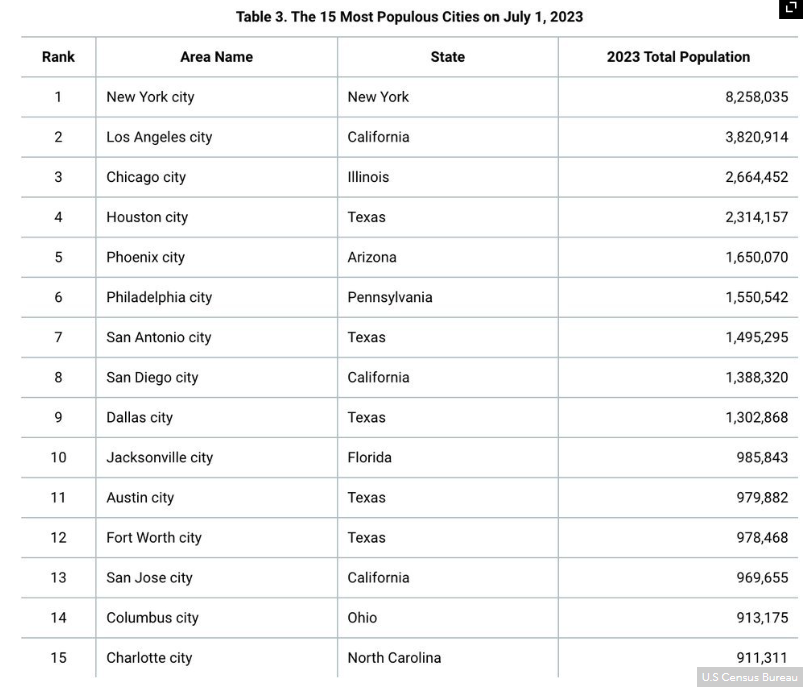Get Issuer Alerts
Add this issuer to your watchlist to get alerts about important updates.
We're No. 12! Fort Worth Population Continues To Go Boom
View allMay 16, 2024
News
The city regains its status as the 12th-largest city in the America. Austin, that's us right on your rear.
Fort Worth, with a population of 978,468, has regained its status as the 12th-largest city in the U.S., moving past San Jose, California, according to estimates released on Thursday by the U.S. Census Bureau.
The city is a mere 1,400 behind No. 11 Austin and 7,300 behind No. 10 Jacksonville, Florida.
Dallas, at 1,302,868, is the ninth-largest city in America. Big D added 5,500 people, a 0.42% increase.
Fort Worth enjoyed the second-largest increase for cities with populations more than 20,000 between July 1, 2022, and July 1, 2023, gaining 21,365. San Antonio, population 1,495,295, experienced the largest increase at 21,970.
Of the top 10 cities with the largest increases, five were in Texas, including Houston, Georgetown, and Celina. All 10 were in the South, including Jacksonville. Moreover, eight of the 15 fastest-growing cities were in Texas, including five in North Texas.
“Thirteen of the 15 fastest-growing cities were in the South, with eight in Texas alone,” said Crystal Delbé, a statistician in the Census Bureau’s Population Division.
Celina’s population grew by 26.6%, more than 53 times that of the nation’s growth rate of 0.5%.
Texas’ 2023 estimates stood at 30.5 million, up almost 475,000 people from 2022.
In 2020, census analysts projected Fort Worth to reach a population of 1 million by 2028. Since 2010, the city has added more than 237,000 people.
In Fort Worth, it's not just the population that is growing. New projects the City Council has incentivized are expected to add 4,000 jobs this year.
“Our success as a city is contingent upon our commitment to quality of life policies and investments,” Mayor Mattie Parker said last week at the United States Conference of Mayors meeting in Fort Worth. “People are quite literally voting with their feet. When people could live anywhere, they’re choosing to live in Fort Worth.”
Amid notable examples of growth in the South, other fast-growing cities saw their rates of population change slow. For example, population growth in Georgetown slowed by more than one-fourth its population growth in 2022, from 14.4% to 10.6%.
New York (8.3 million) remained the most populous city in the U.S., followed by Los Angeles (3.8 million), Chicago (2.6 million), Houston (2.3 million), and Phoenix (1.6 million).
Los Angeles lost only 1,800 people last year, following a decline in the 2020s of almost 78,000 residents. Chicago, which has lost almost 82,000 people this decade, only had a population drop of 8,200 residents last year.
And San Francisco, which has lost a greater share of residents this decade than any other big city — almost 7.5% — actually grew by more than 1,200 residents last year.
For the first time in 66 years, Detroit grew in population, a fact that Mayor Mike Duggan said was cause for "a day of celebration" for Michigan's largest city.
Detroit gained 1,852 people, putting the city's population at 633,218. It marks the first time the city has gained population year over year since 1957.
The nation’s housing stock grew by about 1.6 million units between July 1, 2022, and July 1, 2023, reaching a total of 145.3 million. The 1.1% increase was nearly the same as the 1.2% increase between 2021 and 2022.
Tarrant County was among the top 15 in the country with 17,194 housing units added. Denton and Dallas, 14,296 and 13,644, respectively, earned spots, as did Collin County, which had the fifth most added in the country at 18,000.
California had the largest number of housing units (14.8 million), followed by Texas (12.4 million) and Florida (10.5 million), while Wyoming (280,000) and Alaska (330,000) had the fewest housing units.


